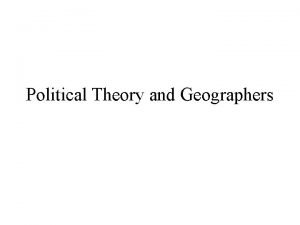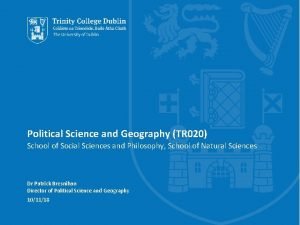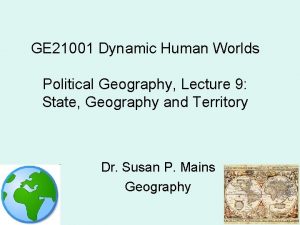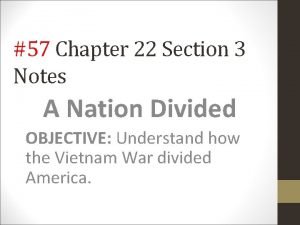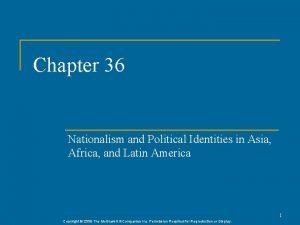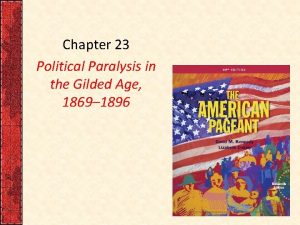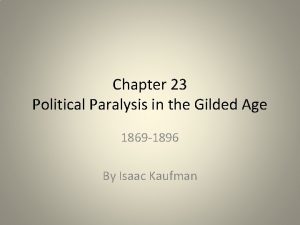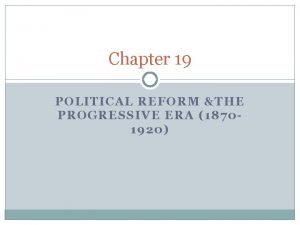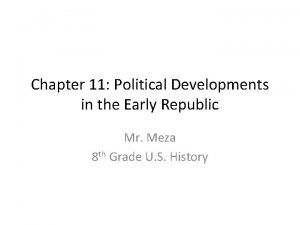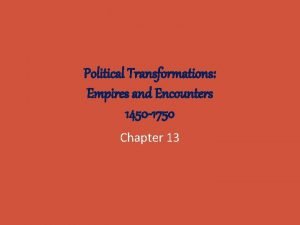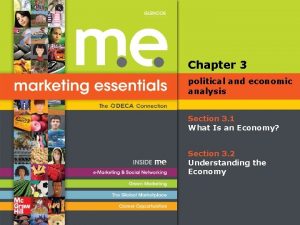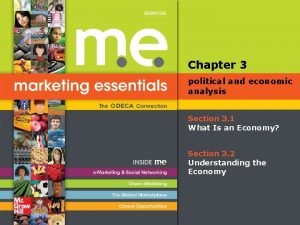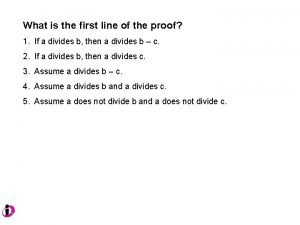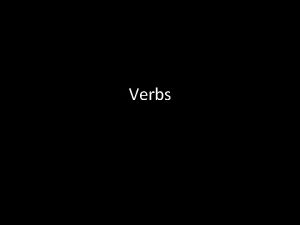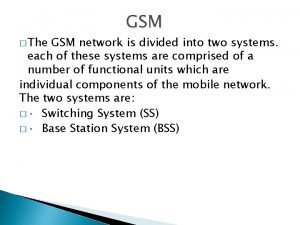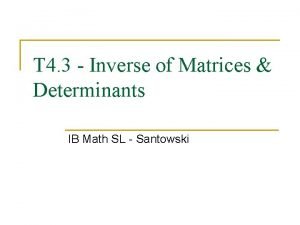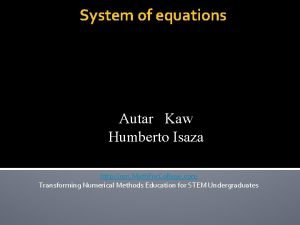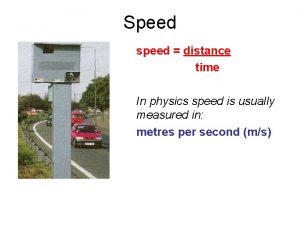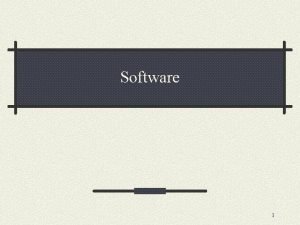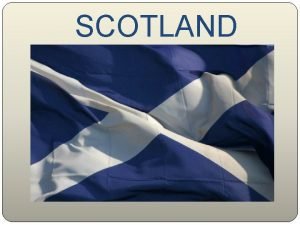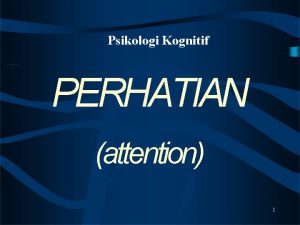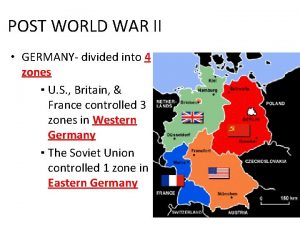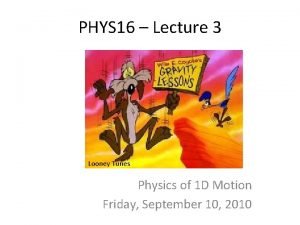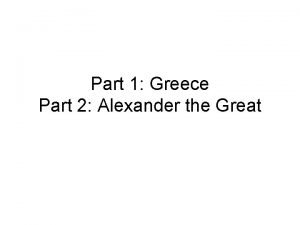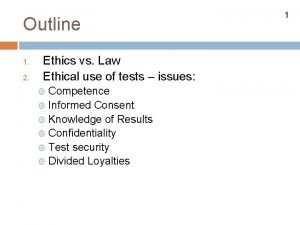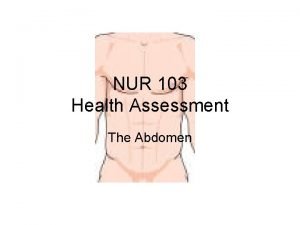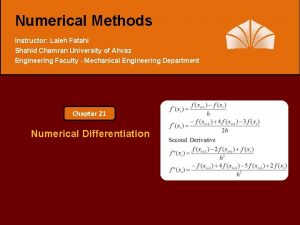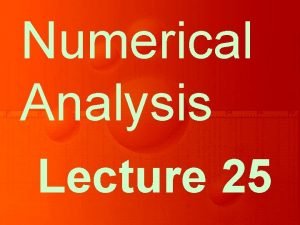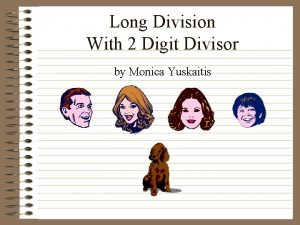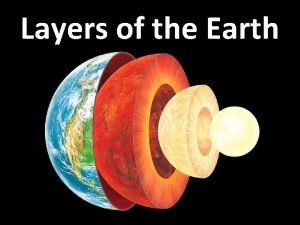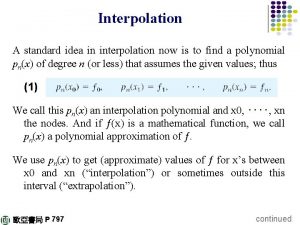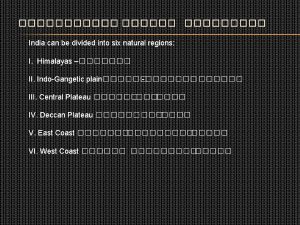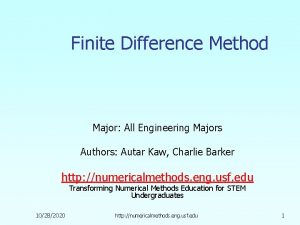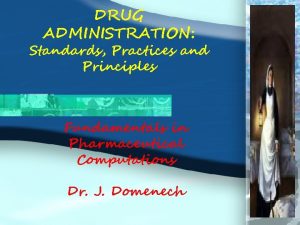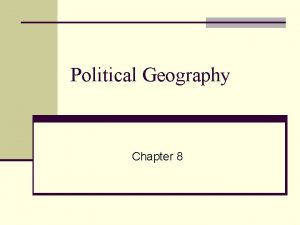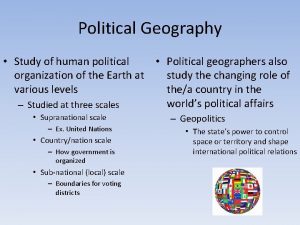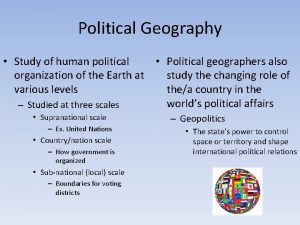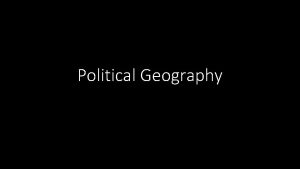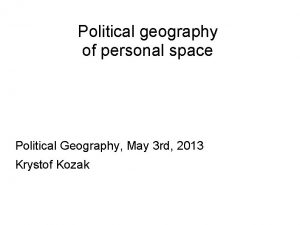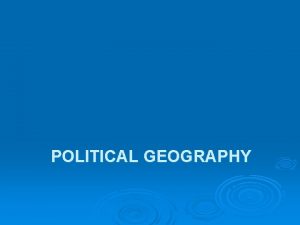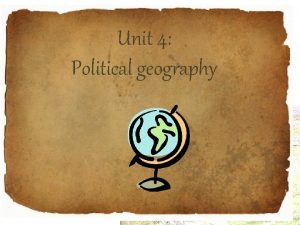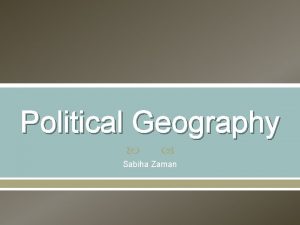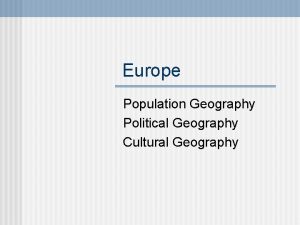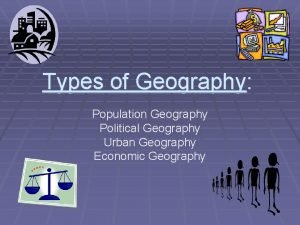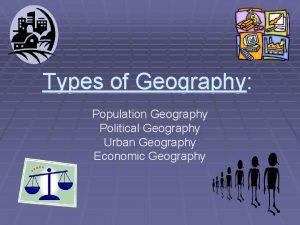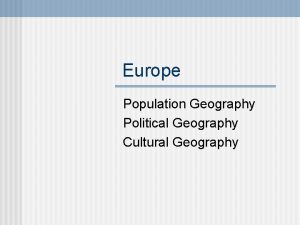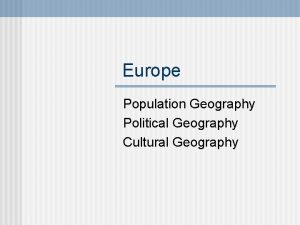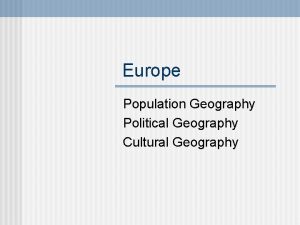POLITICAL GEOGRAPHY CHAPTER OUTLINE This chapter is divided






















































- Slides: 54

POLITICAL GEOGRAPHY 第四章

CHAPTER OUTLINE • This chapter is divided into two major parts: Know the Concepts and Know the Models. • The concepts section contains examples of political state units and nationalism(国家主义), the organization of states, spatial concepts and borders, electoral representation, political-economic systems, and finally, geopolitics. • The models section details Mackinder’s Heartland-Rimland model, Cohen’s Shatterbelts, and Cold War containment theory(抑制理论).

CHAPTER OUTLINE • 1. KNOW THE CONCEPTS • 2. KNOW THE MODELS

1. 1 UNITS OF POLITICAL ORGANIZATION • There a number of political geography terms such as nation and state that we use in everyday speech as synonyms(同义词). However, the technical definitions of these terms have specific and important meaning in the geography of politics. Here’s how to keep them straight: • Country: an identifiable land area • Nation: a population with a single culture • State: a population under a single government • Nation-state: a single culture under a single government


NATION AND STATE • A nation is the same as a culture group. • “State” implies that there is a sovereign territory. Sovereignty generally means that a state is fully independent from outside control, holds territory, and that it has international recognition from other states or the United Nations.

MULTINATIONAL STATES • These examples, the United States, and most other sovereign states are multinational states made up of a number of different nations represented by the multitude of culture groups who have migrated and intermixed around the world. • Multinational, sometimes called multi-ethnic states, are most common in the Americas, where there are no nationstates.

NATION-STATES • There a number of nation-states in which one culture group is represented by a singular government. Many are smaller states or island countries. Although no nation-state is truly made up of only one cultural group, places such as Japan, Iceland, Tonga(汤加), Ireland, Portugal(葡萄牙), and Lesotho (莱索托,pronounced Lesu-too) are places that have not seen permanent invasion or mass immigration from other culture groups in their histories.

NATIONALISM 民族主义 • Nationalism can derive from an existing culture group that desires political representation or independence, or from a political state that bonds and unifies culture groups. • Politicians use nationalism as motivation to support the state and oppose foreign or other political influences. Individuals tend to take pride in their nationalist identities, even though they or their neighbors may be from a mix of different ethnic backgrounds.

STATELESS NATIONS 无国家民族 • Although many culture groups are politically represented or are part of larger political entities, there are some stateless nations, where a culture group is not included or allowed share in the state political process. Here a few examples:


KURDS 库尔德人 • Kurds are an ethnic group spread across northern Iraq, western Iran, eastern Syria(叙利亚共和国) and southeastern Turkey. A semi-autonomous(半自治的) Kurdistan has existed in Iraq since the U. S. -led invasion in 2003. However, full independence is limited geopolitically due to Turkish government resistance to their sovereignty, based upon Kurdish Marxist rebels(库尔德马克思主义 叛军), the PKK, who have been fighting in Turkey for several decades. Since the start of the Syrian Civil War, Kurds have taken territory and started a semi-autonomous government.

BASQUES 巴斯克人 • Basques are an ethnic group in northern Spain and southwestern France who do not have Celtic(凯尔特人的) or Latin cultural or language roots. In fact, their people’s origin is poorly understood by historians. Spain has granted limited autonomy to the Basque region around the city of Bilbao(毕尔巴鄂), but many Basque nationalists seek full independence and statehood(国家地位). A militant group, ETA, has used terror tactics to fight against Spanish rule.

HMONG 赫蒙族 • Hmong are mountain peoples who have existed in rural highlands isolated from others in Laos, Vietnam, Thailand, and southern China. However, their alliance with the United States against the Communists during the Vietnam War caused many families to leave their traditional homeland. Today many Hmong (pronounced “mung”) have resettled in the upper Midwestern states of Wisconsin (威斯康星州) and Minnesota(明尼苏达州). Hmong immigrants are featured in the 2008 film Gran Torino(老爷车).

OTHER STATELESS NATIONS • Other stateless nations include Karen, Gypsies (Roma or Romani), Karelians, Tartars, Tuvans, Chechens, Sami, Uygurs (pronounced Vigers), Tibetans, and Tamils. Some groups have been granted limited autonomy, while others have active nationalist an independence movements. • See the section on irredentism in this chapter for more on independence and sovereignty in the post-Soviet era.

1. 2 ORGANIZATIONS OF STATES

THE BIG FELLAS • Federal states(联邦制国家) and confederations(邦联) are a common approach to government. The United States, Australia, Canada, Germany, Brazil, Russia, and Mexico are all confederations of several smaller states or provinces under a federal government. Like an umbrella, the federal state provides military protection, administers foreign diplomacy, and regulates trade as well as a number of internal administrative (executive branch), legislative, and judicial services across the country. • The states each have their own governments, legislatures, regulations and services. The overlapping roles in the administration may seem redundant(多余的), but each has their own division of responsibilities. For instance, the federal government regulates interstate trade, whereas states can make rules about the sale of goods within each state.

THE WEE FELLAS • At the other end of the international scale, microstates are sovereign states that despite their very small size still hold the same position of much larger states like the United States or Canada. Many are island states, ports, or city-states, or they sit landlocked( 被陆地所包围) with no access to the sea. The following table provides a list of microstates that are full members of the United Nations (UN):


MULTI-STATE ORGANIZATIONS • Supranationalism(超国家主义) is the concept of two or more sovereign states aligned together for a common purpose. A number of supranational organizations have been formed for the purposes of trade alliances, military cooperation, and diplomacy.

UNITED NATIONS • The largest of these is the United Nations (193 member states) whose purpose is primarily diplomatic. The UN also provides a number of services internationally through its World Health Organization (WHO), Food and Agriculture Organization (FAO), Development Program (UNDP), International Children’s Education Fund (UNICEF), peacekeeping forces, and other smaller directorates such as the UN High Commissariat(粮食补给) for Refugees (UNHCR). Each of these units is an important supranational organization in its own right.

DETAILED EXAMPLE: THE EU • Another important supranational organization with several purposes is the European Union (EU). In 2013, the EU grew to 28 member states with a small number of applicant states awaiting membership. The EU was named in 1991 under the Treaty of Maastricht, (马斯特 里赫特条约) which expanded the organization’s role beyond trade relations. • Prior to that, the European Coal and Steel Community (created in 1957) helped strengthen steel production between Italy, France, Luxembourg, Belgium, and the Netherlands. The success of this limited free-trade network encouraged the development of the European Economic Community, “the Common Market” or EEC. By 1973, the EEC eliminated all tariffs on trade goods between its 12 Western European member states. • Today, the EU acts like a federal government for Europe but lacks some of the administrative aspects of other confederations like the United States. The modern EU serves five main purposes

FIVE MAIN PURPOSES OF THE MODERN EU • Free-trade union: • Open-border policy: • Monetary union: • Judicial union: • Legislative and regulatory bodies:

FREE-TRADE UNION • No taxes or tariffs are charged on goods and services that cross the internal borders of the EU. By eliminating these fees, European businesses can save money and be more economically competitive with the United States and Japan.

OPEN-BORDER POLICY • Between EU member states there are no longer any border controls stations for immigration or customs inspections. People and commercial vehicles cross internal EU borders without stopping. This began with the Schengen plan in 1985 when West Germany, France, Belgium, Luxembourg, and the Netherlands opened their borders to one another. Workers can now take jobs in other EU states without applying for work permits (some professions may be protected from this).

MONETARY UNION • In 2000 the first EU members began converting to the Euro(欧元) and phasing out their old forms of money. This eliminated the costs of currency exchange fees. Only 12 members retained their own currencies. The United Kingdon kept the British pound due to its high value—converting to the less valuable Euro would have cause significant financial problems in the United Kingdom. New member states have to meet strict EU economic regulations before they can join the monetary union. • However, the world financial crisis of 2008 revealed some weaknesses of the Euro as indebted countries were unable to devalue (使贬值)the Euro as they’d been able to with national currencies. Countries like Greece, Ireland, and Portugal received bailouts(紧急救助) as part of the Eurozone crisis. These events have forced countries to question the desirability of using the Euro currency.

JUDICIAL UNION • The European Court of Justice in Luxembourg(卢森堡) provides a legal venue (审判地) for cases between litigants in separate EU member states. With the increase in cross-border trade and labor, there were bound to be lawsuits and contract issues that would require the EU’s decisions. In addition, a European Court of Human Rights has been established to preserve civil rights regardless of their member states’ local laws.

LEGISLATIVE AND REGULATORY BODIES 立法和监管 • The 785 -seat EU Parliament(议会) was established to propose and approve laws within the union. The European Commission(欧 盟委员会) is a separate council with one seat for each member state. Each year the presidency shifts to one member state, allowing it to set the year’s policy agenda. The European Commission also acts as the executive branch of the union to enact programs and enforce regulations set by the EU Parliament and Council. The EU Commission president is appointed by the European Council(欧洲理事会).

THE EU AS THE WORLD’S LARGEST ECONOMY • In sum, EU governance has been successful in creating a singular economy through free trade, open borders, free movement of labor, free exchange of currency, and a level playing field for business and labor in terms of laws and regulations. Instead of 28 small economies, the EU acts as one state economy that is highly competitive with the United States, Japan, and emerging economies like Russia, China, India, Brazil, or a proposed Free Trade Zone of the Americas. In terms of total gross domestic product (GDP), the 2012 CIA World Factbook reports the EU has an economy just over 17 trillion compared to a U. S. economy just under 17 trillion dollars.

SOMETHING ROTTEN IN DENMARK? • Despite the economic success of the EU, a number of problems have emerged from the perspective of its citizens and member states. Even though free trade, open borders, and the Euro reduced the cost of doing business and reduced the cost of goods and services, the EU government’s main source of revenue is a 17. 5 percent sales tax, known as the value-added tax(增值税) or VAT. Many complain that the cost of EU governance has significantly increased the cost of many items in Europe. Member state governments have also complained that the European courts have threatened the sovereignty of national and local courts and laws.

内忧外患 • Likewise, open borders have made it difficult to control crime and terrorism. Once someone gets inside the EU’s borders, he can move around freely regardless of citizenship, making it difficult to stop and apprehend criminals. • Externally(外部地), the EU has had to strengthen its borders against illegal immigration and the flow of contraband(走私货). The term Fortress Europe has been used to describe the concept of sealing EU borders. This is a rather difficult problem, since much of the eastern borders of the EU are undefended(无防备的) and only road and rail border crossings are inspected by immigration or customs officers.

NO CONSTITUTION FOR YOU! YET… • In terms of further expansion of the EU system of governance, a European Union Constitution(欧盟宪法) was proposed for ratification in 2004. The complex 65, 000 word document was poorly understood by the citizens and members of parliament who had to vote on the constitution. Concepts like a common EU foreign policy among all states were unclear. Many voters and politicians were concerned about the continued loss of sovereignty for member state governments. Political leftists saw the constitution as being too pro-business. And right-wing sentiment against Turkey in the EU also resulted in “No” votes against ratification. The constitution was voted down in the Netherlands(荷兰) and France in 2005, thus forcing the European Commission to go back to the drawing board.

ADDITIONAL SUPRANATIONAL ORGANIZATIONS

1. 3 SPATIAL CONCEPTS OF POLITICAL GEOGRAPHY • Territoriality(领土性质或状态) is the expression of political control over space. The concept of the state implies that the government controls land the people who live there. • Citizenship is the legal identity of a person based on the state where he was born or where he was naturalized as an immigrant. Keep in mind that when citizens go outside their state’s political borders, they retain their citizen status and thus become an extension of their state (unless they apply for new citizenship as immigrants). This is why we strictly define the state as a population represented by a single government, without mentioning territory. However, don’t forget that space matters; as it’s not much of a state if it has no land, which can happen in the case of a government in exile(流放), such as the Dutch(荷兰) or Polish governments during World War II.

POLITICAL BORDERS • The borders between political states and political sub-unit areas (counties, parishes, parliamentary districts, and city limits) are strictly finite lines. Political boundaries, as expressions of political control, must be definable and clear. • Sometimes the physical geography, such as rivers or other water bodies, define boundaries, and sometimes border lines are measured surveys based on treaties or other agreements between states. Nonphysical boundaries often reflect cultural divisions, but these are not always accurate. Such borders can be the result of aristocratic(贵族的) land holdings from Feudalistic(封建性的) eras, or be the front lines at the secession(脱离) of armed conflict between states—however, treaties can change these lines.

OUTSIDE THE LINES • Countries with large expatriate(被流放的) populations (citizens living outside of their borders) have to provide consular(领事的) services in large foreign cities. Citizens living in foreign countries often have to visit their country’s embassies or consulates(领事馆) to process legal documents, passports, and visa applications. When citizens get trapped in war zones or disasters in foreign countries, it’s up to their government’s diplomats and military to get them out.

ENCLAVE AND EXCLAVE • Borderlines may be finite, but they can become quite irregular in pattern especially where the cultural borderlines become fuzzy. An enclave(飞地) is a minority culture group concentrated inside a country that is dominated by a different, larger culture group. This could be as simple as an ethnic neighborhood or a large area such as Québec(魁北克 ). • As part of the 1994 Dayton Peace Accords, several enclaves were formally established within Bosnia to separate warring Serb, Croat, and Muslim communities.

EXCLAVE • An exclave is a fragmented piece of sovereign territory separated by land from the main part of the state’s territory. Occasionally, neighboring states attempt to claim exclaves in the name of cultural nationalism. Often armed conflicts result, but sometimes diplomatic negotiations result in official permanent exclaves. Other times states purchase territory or receive fragments of territory under peace treaties. Islands are not considered exclaves. Here a few examples of exclaves:


WATER BORDERS AT SEA • Historically, borders at sea were poorly defined, and each country had its own laws regarding where territorial claims began and ended. Often, more than one sovereign state claimed the same piece of water. This all changed in 1982 with the United Nations Conference on the Law of the Seas (UNCLOS), which proposed standard oceanic boundaries for all UN member states, and was fully ratified(批准的) in 1994. The border system under UNCLOS is in the following two parts:

TERRITORIAL SEA • Sovereign territory includes the area of sea from shore out to the 12 -nautical-mile limit. Within 12 nautical miles all the laws of a country apply.

EXCLUSIVE ECONOMIC ZONE(EEZ) 专属经济区 • Exclusive economic rights from shore out to the 200 -nautical-mile limit. Within 200 nautical miles of its shores, a state controls all aspects of natural resource exploration and extraction. This includes fisheries, oil and gas production, salvage operations(打捞作业), and permits for such activity. Two hundred nautical miles is beyond the shallow water continental shelf in almost all cases.

EEZ BOUNDARIES AND HIGH SEAS OFF THE EASTERN UNITED STATES

HIGH SEAS 公海,远海 • The high seas are technically outside of the 12 -mile limit. Past that line, cruise ships(巡游船) can open their casinos(赌场) and ship captains gain the authority to marry couples or arrest thieves onboard their ships. These are provisions(规定) made under admiralty law(海商法), a part of international law that dictates legal procedures(规定法定程序) on the high seas. Beyond the 200 -mile limit, international fishing fleets(舰队) can hook or net whatever ocean life they choose and in unregulated(不受监管的) amounts.

INTERNATIONAL WHALING COMMISSION • The only exceptions are when international treaties limit the capture of certain species. The 1986 International Whaling Commission moratorium(暂停) on commercial whale hunts banned whaling after centuries of hunting dangerously depleted populations. Norway and Japan still hunt whales, claiming their hunts are for scientific research. This claim is heavily criticized by environmental organizations who state that whale meat still makes it way to market in these countries.

INTERNATIONAL POLITICAL BORDERS COMPARED TO EEZS AND TERRITORIAL SEAS

POLITICAL BORDERS ON THE MAP, NOT EEZS • When you look at the map above you can see that normal political boundaries and the real EEZ boundaries are very different. The cartographic borders are often rectangular around islands. In reality, territorial seas and EEZs create circular boundaries, especially around islands—each of which extends a country’s EEZ out another 200 nautical miles.

OVERLAPPING BORDERS AT SEA AND DISPUTES • The UNCLOS makes provisions for a UN arbitration board to settle disputes regarding boundaries at sea. Often countries with overlapping sea claims generally agree to split the lines halfway. Where it becomes difficult is when uninhabited small islets, exposed reefs, and sandbars above water are claimed by more than one country. It can take years of negotiation to settle such disputes, and occasionally troops are deployed to precariously small pieces of land, just to claim rights to the surrounding EEZ. • For example, two areas of the South China Sea, the Spratly Islands(南沙群岛) and the Paracel Islands(西沙群岛), are claimed concurrently by China, Vietnam, Indonesia, the Philippines, Malaysia, and Brunei. Oil is believed to be under both island groups, and these areas of potential future armed conflict if arbitration fails.

BOUNDARY ORIGINS AND BORDER TYPES • This topic can be confusing due to the varied terminology used to describe processes behind boundary creation and the types of borders that exist. Let’s see if we can simplify this:

• Boundary Origins • Important Historical Examples: • Antecedent: Boundary lines that exist from • Antecedent: French-Spanish border along the Pyrenees (庇里牛斯山) prehistoric(史前的) times • Relic: Former state boundaries that still have political or cultural meaning • Relic: Scotland-England border after The Act of Union in 1652 • Subsequent: German-Polish border after 1945; • Subsequent: Lines resulting from conflict Kaliningrad(加里宁格勒) to the USSR(前苏联)in or cultural changes, such as war and 1946 migration • Superimposed: Sub-Saharan Africa after the Berlin • Superimposed: Lines laid down for political Conference of 1884; Yugoslavia(南斯拉夫) and Iraq after the 1919 Treaty of Versailles (凡尔赛和约,Each of reasons overtop cultural boundaries these resulted in recent conflicts. )

BOUNDARY PROCESS • Definition: When borders are claimed, negotiated, or captured • Delimitation(定界;限定): When borders are put on the map • Demarcation(划界): When markers are placed on the ground to show where borders lay

BORDER TYPE • Physical: Natural boundaries—rivers, lakes, oceans, mountains, or deserts • Cultural: Estimated boundaries between nations, ethnic groups, or tribes • Geometric: Boundaries surveyed mostly along lines of latitude and longitude

• Border Disputes • Important Historical Examples: • Definitional: When border treaties are interpreted two different ways by states • Definitional: Russian-Japanese Kuril Islands( 千岛群岛) under Soviet control in 1945 • Locational: When the border moves, like a river changing course or lake drying up • Locational: India-Bangladesh(孟加拉国) territory along the Ganges-Brahmaputra(恒河雅鲁藏布江) River Delta • Operational: When borders are agreed to, but passage across the border is a problem • Operational: New passport requirements for entry into the United States after September 11, 2001 • Allocational: When a resource lies on two sides of a border. Who gets what? • Allocational: Mexico-United States river allocations for irrigation and drinking water on the Colorado River and Rio Grande (格兰德河,Rio Bravo)

BORDER CONFLICTS: FRONTIER WAR(边疆战争) OR PEACE? • Historically, when land was either unexplored or unsurveyed, the term frontier was used to describe the open and undefined territory. There a few disputed small frontier regions in the world today. The only remaining large land frontier is Antarctica, where the Antarctic Treaty (1959) has set aside the continent (actually several large islands covered by an ice cap) for scientific research and prohibits any military action and commercial mineral or energy extraction.
 Ap human geography political geography frq
Ap human geography political geography frq Proruption ap human geography
Proruption ap human geography Citation sandwich example
Citation sandwich example Classification of boundaries in political geography
Classification of boundaries in political geography Objectives of political geography
Objectives of political geography Political geography of australia
Political geography of australia Relationship between political science and geography
Relationship between political science and geography Europe map 1990
Europe map 1990 Boundaries ap human geography
Boundaries ap human geography Compare geometric boundaries and antecedent boundaries.
Compare geometric boundaries and antecedent boundaries. Political geography
Political geography Centrifugal force in india
Centrifugal force in india 5 themes of geography ap human geography
5 themes of geography ap human geography A nation divided chapter 22 section 3
A nation divided chapter 22 section 3 Chapter 4 section 1 federalism powers divided
Chapter 4 section 1 federalism powers divided Chapter 35 nationalism and political identities in asia
Chapter 35 nationalism and political identities in asia Chapter 36 nationalism and political identities in asia
Chapter 36 nationalism and political identities in asia Chapter 23 political paralysis in the gilded age
Chapter 23 political paralysis in the gilded age Political paralysis in the gilded age
Political paralysis in the gilded age Chapter 19 political reform and the progressive era
Chapter 19 political reform and the progressive era Political developments in the early republic
Political developments in the early republic Chapter 5 political transformations empires and encounters
Chapter 5 political transformations empires and encounters Chapter 3 political and economic analysis
Chapter 3 political and economic analysis Chapter 3 political and economic analysis
Chapter 3 political and economic analysis Chapter 23 political paralysis in the gilded age
Chapter 23 political paralysis in the gilded age A devides b
A devides b Latin verbs are divided into
Latin verbs are divided into Mobile services switching center
Mobile services switching center Dividing matrices
Dividing matrices Can matrices be divided
Can matrices be divided Distance divided by time
Distance divided by time Solute vs solvent
Solute vs solvent Software divides into
Software divides into Sign shapes meaning
Sign shapes meaning Seed plants are divided into two groups called
Seed plants are divided into two groups called Scotland is divided into
Scotland is divided into Divided attention definition
Divided attention definition Bulk granules
Bulk granules Germany divided after ww2
Germany divided after ww2 Acceleration divided by time
Acceleration divided by time How many generals divided alexander's empire?
How many generals divided alexander's empire? Sfeedtest
Sfeedtest Finely divided catalyst
Finely divided catalyst Obiturator
Obiturator Finite divided difference
Finite divided difference Newtons
Newtons Mother and child, divided
Mother and child, divided Alternating attention vs divided attention
Alternating attention vs divided attention Divide negative numbers
Divide negative numbers How to do long division 2 digit
How to do long division 2 digit 3 layers of the earth
3 layers of the earth Interpolation formula
Interpolation formula 6 natural regions
6 natural regions Finite difference equation
Finite difference equation Pediatric dose calculation formula
Pediatric dose calculation formula



